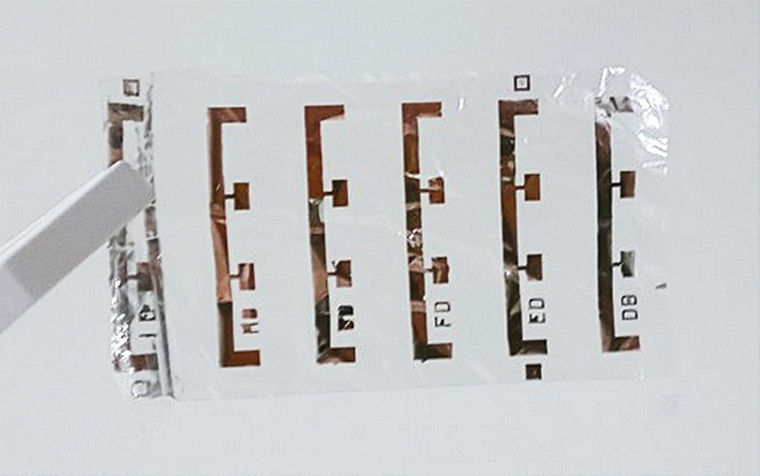E-skin technology helps humans evolve ‘sixth sense’
Courtesy LEIBNIZ INSTITUTE FOR SOLID STATE AND MATERIALS RESEARCH IN DRESDEN
Segments of the magneto-sensitive e-skin were tested for flexibility and durability in Dresden, Germany.
February 16, 2015
In the animal kingdom, it is common for different species to have heightened senses that help them survive. For example, homing pigeons use their magnetoception—the ability to detect magnetic fields—to navigate the planet effectively and find their way home.
Human innovation has historically been inspired by the world around us, selecting traits observed in the natural world and artificially adapting them for our use, but how might magnetoception apply to daily life?
Scientists at the Leibniz Institute for Solid State and Materials Research in Dresden, Germany, collaborated with the University of Tokyo’s Department of Electrical and Electronic Engineering to develop an electronic skin that can be applied anywhere on the body, giving people the ability to perceive magnetic fields—a man-made “sixth sense.”
“You’re not really ‘feeling’ the field,” said Dr. Martin Kaltenbrunner, an instructor and researcher at the department of soft matter physics at Johannes Kepler University in Linz, Austria. “The electronics ‘feel’ it for you.”
The collaboration’s experimentation, published Jan. 21 in the journal Nature, is based on more than five years of planning and research into flexible and stretchable magnetic sensors and electronics that are imperceptible when applied to skin. The most recent portion of the research investigated the connection between these fields of study.
“We met Martin Kaltenbrunner at the Materials Research Society conference in San Francisco in the spring of 2013,” said Michael Melzer, a Ph. D. student at the Leibniz Institute in Dresden. “It all began with the establishment of this contact.”
The idea behind magnetoception is affixing several magneto-sensitive elements that resemble a compass on the skin to detect small magnetic fields around the wearer of the electronic skin, said Dr. Denys Makarov, a researcher at the Leibniz Institute in Dresden.
According to the paper, the materials that were used to embed the electronic skins with magnetic perception are commonly found in plastics and electronics. Polyethylene terephthalate, or PET foils, is a polymer known to be ultra thin, lightweight and flexible. The researchers assembled a stack of highly sensitive copper and cobalt magnets that rely on a giant magneto-resistive effect, which is seen in conductive, thin film structures.
During the experiment, these sensing, magnetic elements turned out to be very effective when conforming to deformations on the skin, lasting for more than a thousand cycles of use and sustaining no damage to the device.
In addition to orientation and navigational uses, medical applications are also being explored, according to Makarov. He said many smart devices on the market today are seeking ways to monitor health while generating instant feedback.
Makarov said these sensors could be applied to reading muscle movement and cardiovascular irregularities very accurately and in real time.
“The advantage would be to detect potential health risks at early stages,” Melzer said. “If we can integrate [the magnetic sensors] with wireless communication modules, one could have immediate alerts [sent] to a mobile device in case something is wrong in the body, and then immediately inform a doctor.”
Kaltenbrunner’s early work with UTokyo also looked at ultra-thin sensors that could be attached to the body. With his colleagues in Tokyo, Kaltenbrunner created the imperceptible e-skin prototypes that would ultimately contain the magnetic sensors. These were then sent to Dresden, where the experimentation phase of the project took place. In regards to on-skin electronics, Kaltenbrunner said many regulations force researchers to take time to test the devices for general safety.
“Soon there will be collaboration at UTokyo with their medical faculty because it’s necessary when technology deals with this kind of integration,” Kaltenbrunner said.
It will take more research and the collaboration of facilities around the world before e-skin can be sold for medical use, he said.
Interaction with magnetic sensor technology through mobile devices is already being considered for consumer use, and the researchers agree that the technology has now reached a prototype phase and may be ready for commercial use in just a few years.
In reality, it will take even more creativity and teamwork in the next few years with designers, investors and marketers collaborating to bring this technology to the public, Kaltenbrunner said.
“This project all started with a little bit of inspiration and a simple student exchange,” Kaltenbrunner said. “You can find something interesting about any subject, but with others with different areas of expertise involved, it develops into something great.”








